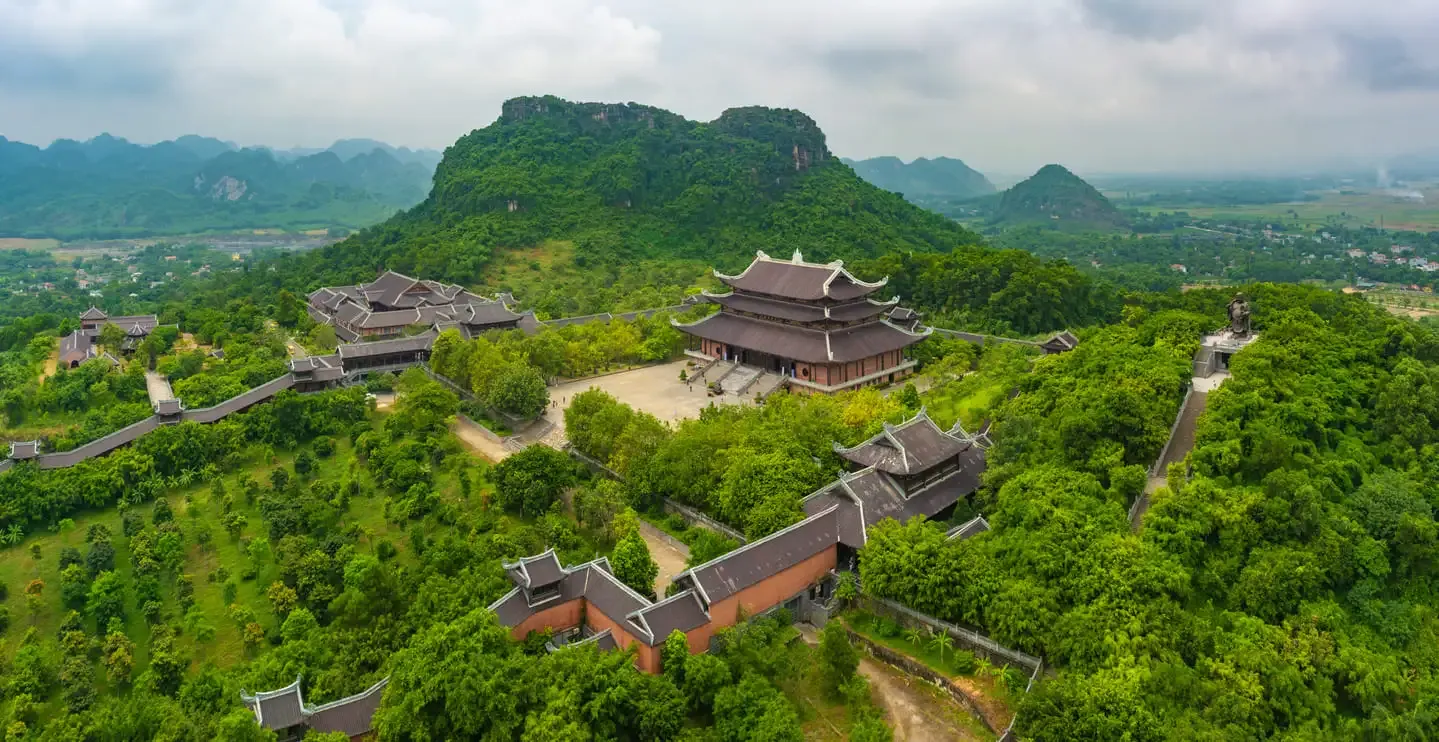

Bai Dinh Pagoda, a symbol of Buddhist culture and religion in Vietnam, is a must-see destination for those who love immersing themselves in a sacred and contemplative space. With its massive architecture and mysterious beauty, Bai Dinh Pagoda is not only a place to relax but also an opportunity to learn about the history, art and spirituality of the Vietnamese people. Let's explore this temple in more detail with BDATrip.
Bai Dinh Pagoda is one of the famous attractions in Vietnam, located in Gia Sinh commune, Gia Vien district, Ninh Binh province, about 100km south of Hanoi. The pagoda was built on a large area, with extremely impressive architecture and Buddhist culture. In particular, Bai Dinh Pagoda is famous for the largest pagoda in Southeast Asia and the largest bronze Buddha statue in the world.

Bai Dinh Pagoda originated from the Ly - Tran period (11th-13th centuries), when a legendary monk named Ngo Khong chose this location to practice and create a small temple. However, by the 19th century, Bai Dinh Pagoda was heavily damaged by time and war, and then construction was restarted in the 20th century. The significant development of Bai Dinh Pagoda began from in 2003, when the expansion and upgrading project was initiated. Construction took years and was completed in 2010 with the inauguration of Southeast Asia's largest temple and the world's largest bronze Buddha statue.

During the development and construction process, Bai Dinh Pagoda witnessed many notable historical and artistic events. This is where traditional festivals, ceremonies honoring Buddhism and cultural and artistic events take place, creating a lively and rich space for visitors. In particular, works of art in the temple grounds such as bronze Buddha statues, deity statues and murals are also notable highlights, enhancing the beauty and cultural value of Bai Dinh Pagoda. .
Bai Dinh Pagoda is a set of architectural works built on a large area, including many areas such as pagodas, communal houses, temples and other auxiliary works. The overall structure of Bai Dinh Pagoda is divided into two main parts: the old pagoda and the new pagoda.
Located on the east side of the pagoda campus, the ancient pagoda was built in the Ly - Tran period and is considered the original pagoda of Bai Dinh. This is where many ancient relics, Buddha statues and precious Buddhist treasures are stored.

Built during the process of expanding and upgrading Bai Dinh Pagoda from 2003 to 2010. The new pagoda is a large-scale modern architectural work, including many items such as pagoda towers, large halls, and fountains. water and chimes.
The Buddhist architectural style of Bai Dinh Pagoda combines traditional and modern elements, demonstrating the blend of national culture and Buddhist religion. The temple's architecture reflects majesty, solemnity and sophistication, creating a sacred and spiritual space for Buddhist believers and tourists.
Within the grounds of Bai Dinh Pagoda, visitors can see many unique and beautiful works of art, from Buddha statues with deities to statues symbolizing peace and happiness. The exquisitely hand-painted murals, depicting stories from Buddhist scriptures, are also a highlight not to be missed. Visitors can also admire the splendid golden bell tower, which houses precious Buddhist scriptures and is where important religious ceremonies are held.
In addition, other artistic works such as chimes, fountains and stone sculptures also contribute to increasing the appeal of Bai Dinh Pagoda, creating an impressive and profound cultural and spiritual space. .
Route: To get to Bai Dinh Pagoda from Hanoi, you can choose many means of transport such as personal car, tour bus or organized tour. The journey will take about 2-3 hours depending on traffic conditions and route chosen.
Beautiful Scenery on the Road: During the journey to Bai Dinh Pagoda, visitors will admire the beautiful Bai Dinh landscapes of the Vietnamese countryside, from lush green rice fields to traditional villages along the road.
Transportation and Facilities: The road to Bai Dinh Pagoda is usually quite convenient and easy to go, with many stops and amenities to serve tourists such as cafes, restaurants, and souvenir shops.
When coming to Bai Dinh Pagoda, visitors will enter a sacred and solemn space, with outstanding architectural works and wonderful works of art. Visitors have the opportunity to visit both old and new pagodas, each offering special experiences and insight into history and spirituality. At Bai Dinh Pagoda, visitors can participate in religious activities such as praying, worshiping Buddha, and interacting with believers to understand more about Buddhist beliefs and traditions.
Participate in Festivals: Bai Dinh Pagoda often organizes traditional festivals and spiritual events on major holidays such as Lunar New Year, Buddha's Birthday, and Vu Lan Festival.
Learn about Local Culture: Visitors also have the opportunity to learn about local culture through activities such as watching folk dances, enjoying culinary specialties, and shopping for traditional handicraft products.
Visit Surrounding Tourist Attractions: In addition to Bai Dinh Pagoda, visitors can also visit nearby tourist attractions such as Hang Mua, Tam Coc - Bich Dong, and Hoa Lu historical relics to enrich the experience. your travel.
The architecture of Bai Dinh Pagoda is not only a symbol of sophistication and uniqueness in the art of construction but also a vivid image of Buddhist culture and religion in Vietnam. Hopefully this article will help you get more information about Bai Dinh Pagoda to have a memorable visit.
Copyright © 2022 BDATrip.com | All rights reserved.